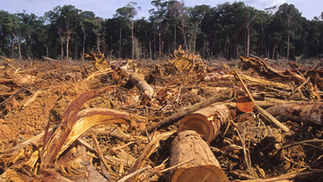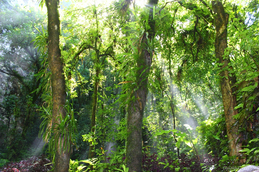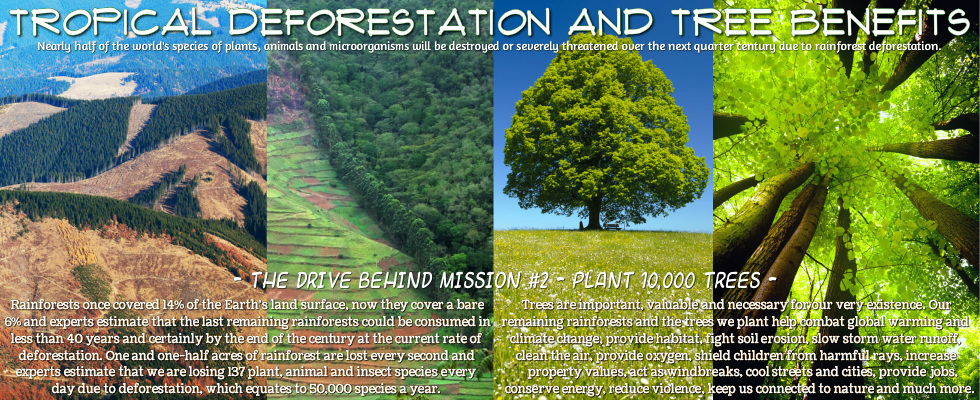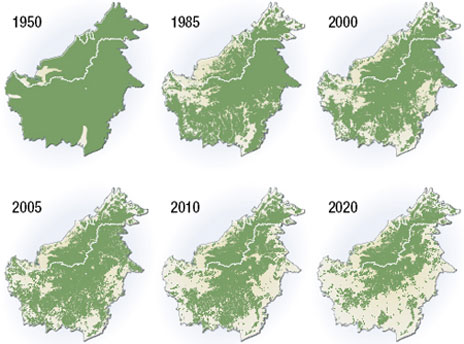The Amazon Rainforest

IAP Statement on Tropical Forests and Climate Change
The Disappearing Rainforests

“In the rain forest, no niche lies unused. No emptiness goes unfilled. No gasp of sunlight goes untrapped. In a million vest pockets, a million life-forms quietly tick. No other place on earth feels so lush. Sometimes we picture it as an echo of the original Garden of Eden—a realm ancient, serene, and fertile, where pythons slither and jaguars lope. But it is mainly a world of cunning and savage trees. Truant plants will not survive. The meek inherit nothing. Light is a thick yellow vitamin they would kill for, and they do. One of the first truths one learns in the rain forest is that there is nothing fainthearted or wimpy about plants.” ~ Diane Ackerman , Poet, Essayist, and Naturalist
The True Financial Wealth of Rainforests

20 Reasons to Plant a Tree
Trees Combat the Greenhouse Effect
Global warming refers to the unusually rapid increase in Earth’s average surface temperature over the past century primarily due to the greenhouse gases released by the burning of fossil fuels and cutting down of forests. Carbon dioxide is a major greenhouse gas, which trees absorb as they remove and store the carbon while releasing oxygen back into the air. When trees die, they release the carbon they've been holding for perhaps centuries into the atmosphere further trapping heat from the sun. In one year, an acre of mature trees absorb the amount of carbon dioxide produced when you drive your car 26,000 miles.
Trees Act as Windbreaks
Windbreaks and shade trees save energy, money and the environment. During windy and cold seasons, trees located on the windward side of a home can lower home heating bills by up to 30% and have a significant effect on reducing snow drifts. A reduction in wind can also reduce the drying effect on soil and vegetation behind the windbreak and help keep top soil in place.
Trees Slow Storm Water Runoff
Stormwater runoff is rainfall that flows over the ground surface. Flash flooding can be drastically reduced by a forest or by planting trees. One mature Colorado Spruce tree can capture more than 1000 gallons of water annually. This slowing down of water runoff recharges underground water-holding aquifers and prevents many different pollutants that are found on paved surfaces such as sediment, nitrogen, phosphorus, bacteria, oil and grease, trash, pesticides and metals, from being carried into the environment.
Trees Provide Habitat
"It is only natural that wherever trees are planted, wildlife and other plants are sure to follow. Trees provide shelter and food for a variety of birds and small animals, such as squirrels and beavers. Enhancing growth diversity, trees create an environment that allows the growth of plants that otherwise would not be there." ~Urban Forestry Network
Trees Shield Children from Harmful Rays
Skin cancer is one of the most common cancers in the world. Trees reduce UV-B exposure by about 50%, providing protection to children on school campuses and playgrounds, which is where children spend most of their time outdoors.
Trees Reduce Asthma
Trees filter airborne pollutants and reduce the conditions that cause asthma. Asthma incidents increase in urban communities where trees are eliminated in favor of new roads, homes or commercial developments. For every extra 343 trees per square kilometer, which equates to 1.5 trees per acre, asthma rates decrease by 29%.
Trees Provide Food
According to FAO, "Although forest foods do not usually provide a complete diet, they do make a critical contribution to the food supply. Forest foods increase the nutritional quality of rural diets; supplement other sources of food -particularly agricultural crops that are only seasonally available; and are used as emergency food supplies during drought, famine and war. Forest foods are nutritionally important and are traditionally used as supplements to the staple diet. Leafy vegetables and wild animals add diversity, flavour, vitamins and minerals to characteristically grain-dominated diets. Forest foods are often collected and stored for later use. Forest foods can thus raise rural peoples' nutritional intake by providing a year-round supply of food." An example is the apple tree, which can grow up to 15-20 bushels a year and be planted on the tiniest of urban lots. Trees also provide food for many birds and wildlife.
Trees Conserve Energy
Three trees placed strategically around a single-family home can cut summer air conditioning bills by up to 50%. By reducing this energy demand to cool our houses, we reduce carbon dioxide and other pollution emissions from power plants and of course, save money!
Trees Increase Physical Activity and Reduce Obesity
Studies have found a correlation between community forests and the average amount of community activities exerted by neighborhood residents. People are more inclined to get outdoors and exercise when their surroundings are greener. According to APA, "Parks can also provide measurable health benefits, from providing direct contact with nature and a cleaner environment, to opportunities for physical activity and social interaction. A telephone survey conducted for the American Public Health Association found that 75 percent of adults believe parks and recreation must play an important role in addressing America's obesity crisiss."
Trees Bring Diverse Groups of People Together
"Tree plantings provide an opportunity for community involvement and empowerment that improves the quality of life in our neighborhoods. All cultures, ages, and genders have an important role to play at a tree planting or tree care event." ~Tree People
Trees Clean the Air
Trees help cleanse the air by acting as giant air filters sequestering carbon, producing oxygen, reducing heat and ground-level ozone, capturing airborne particles and absorbing pollutants, such as carbon monoxide, nitrogen dioxide and sulfur dioxide. Trees are able to remove this air pollution by lowering air temperature through respiration and retaining particulates. A single tree can absorb 10 pounds of air pollutants a year, and produce nearly 260 pounds of oxygen- enough to support two people. Forests act as a giant filter that cleans the air we breathe.
Trees Cool the Cities and Streets
Heat absorbing roads and cities create a "Heat Island" effect, largely due to replacing natural green infrastructure with concrete and dark colored infrastructure, which produces an unhealthy environment to live in by raising the temperature of cities an average of 2 to 10 degrees Fahrenheit warmer than their rural surroundings. By shading our homes and streets, trees help cool cities by up to 10 degrees Fahrenheit, which reduces the urban "Heat Island" effect and releases water vapor into the air through their leaves. Studies suggest that if 10% of city roofs were greenroofs, the ambient temperature would be lowered by 2 to 4 degrees Fahrenheit, which helps save on energy costs, reduces urban smog exposure and more.
Trees are Spiritual Leaders
"The main reason we like trees is because they are both beautiful and majestic. No two are alike. Different species display a seemingly endless variety of shapes, forms, textures and vibrant colors. Even individual trees vary their appearance throughout the course of the year as the seasons change. The strength, long lifespan and regal stature of trees give them a monument-like quality. Most of us react to the presence of trees with a pleasant, relaxed, comfortable feeling. In fact, many people plant trees as living memorials of life-changing events. Trees help record the history of your family as they grow and develop alongside you and your kids. We often make an emotional connection with trees we plant or become personally attached to the ones that we see every day. The sentimental value of a special tree is simply immeasurable." ~ SavATree
Trees Heal the Mind and Body
Studies have shown that patients with views of trees outside their windows heal faster and with less complications. For example, children with ADHD show fewer symptoms when they have access to nature. An exposure to trees and nature aids concentration by reducing mental fatigue. Several studies of non-patient groups, such as university students, as well as patients have consistently shown that simply looking at environments dominated by greenery, flowers, or water, as compared to built scenes lacking nature, such as rooms, buildings, towns, is significantly more effective in promoting recovery or restoration from stress.
Trees Fight Soil Erosion
By keeping the soil intact with their roots and breaking the force of wind and rain on the soil, trees slow water runoff, hold the soil in place, and conserve rainwater and sediment deposits after storms.
Trees Increase Property Values
The value of a real estate increases when trees beautify a property or neighborhood. Trees can increase the property value of a home by 15% of more.
Trees Save Water
"Shade from trees slows water evaporation from thirsty lawns. Most newly planted trees need only fifteen gallons of water a week. As trees transpire, they increase atmospheric moisture." ~Tree People
Trees Provide Oxygen
A mature leafy tree produces as much oxygen in a season as 10 people inhale in a year. According to the New York Times, "One acre of trees annually consumes the amount of carbon dioxide equivalent to that produced by driving an average car for 26,000 miles. That same acre of trees also produces enough oxygen for 18 people to breathe for a year." According to Northwest Territories Forest Management, "A 100-ft tree, 18" diameter at its base, produces 6,000 pounds of oxygen," and according to Environment Canada, "On average, one tree produces nearly 260 pounds of oxygen each year. Two mature trees can provide enough oxygen for a family of four."
Trees Reduce Violence
Barren neighborhoods and homes are shown to have higher rate of violence than their greener counterparts. For example, a study conducted in Baltimore City and Country shows that a 10% increase in tree canopy corresponds to a roughly 12% decrease in crime.Trees and landscaping help to reduce the level of fear and increase the level of inner peace. To view the study, click the photo. To learn more, click the title.
Trees Increase Business Traffic
The more trees and landscaping a business district has, the more business in the district. According to Human Dimensions of Urban Forestry and Urban Greening, "Trees provide environmental benefits in cities, but also contribute to the economy of communities. A program of scientific studies has found that shoppers respond positively to trees in downtown business districts. These findings have been consistent across large, small and mid-size cities of the United States. The most positive consumer response is associated with streets having a mature, well-managed urban forest where overarching tree canopy helps create a "sense of place." Trees planted along a street can also slow traffic enough to slow the driver to look at the storefronts.
| |
"The oaks and the pines, and their brethren of the wood, have seen so many suns rise and set, so many seasons come and go, and so many generations pass into silence, that we may well wonder what "the story of the trees" would be to us if they had tongues to tell it, or we ears fine enough to understand." ~Author Unknown
"It was strangely like war. They attacked the forest as if it were an enemy to be pushed back from the beachheads, driven into the hills, broken into patches, and wiped out. Many operators thought they were not only making lumber but liberating the land from the trees..." ~ Murray Morgan
Reforest the World




























